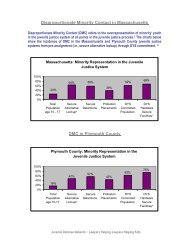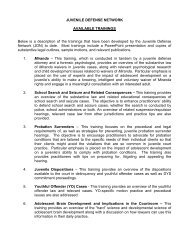States rethink 'adult time for adult crime' - the Youth Advocacy Division
States rethink 'adult time for adult crime' - the Youth Advocacy Division
States rethink 'adult time for adult crime' - the Youth Advocacy Division
Create successful ePaper yourself
Turn your PDF publications into a flip-book with our unique Google optimized e-Paper software.
sense of how severely certain crimes should be punished and <strong>the</strong> actual<br />
punishments assigned by law, federal sentencing guidelines might be revised, on<br />
<strong>the</strong> principle that <strong>the</strong> law shouldn’t diverge too far from deeply shared beliefs.<br />
Experiments might help to develop a deeper understanding of <strong>the</strong> criminal brain,<br />
or of <strong>the</strong> typical brain predisposed to criminal activity.<br />
III. The End of Responsibility Indeed, as <strong>the</strong> use of functional M.R.I. results<br />
becomes increasingly common in courtrooms, judges and juries may be asked to<br />
draw new and some<strong>time</strong>s troubling lines between “normal” and “abnormal”<br />
brains. Ruben Gur, a professor of psychology at <strong>the</strong> University of Pennsylvania<br />
School of Medicine, specializes in doing just that. Gur began his expert-witness<br />
career in <strong>the</strong> mid-1990s when a colleague asked him to help in <strong>the</strong> trial of a<br />
convicted serial killer in Florida named Bobby Joe Long. Known as <strong>the</strong><br />
“classified-ad rapist,” because he would respond to classified ads placed by<br />
women offering to sell household items, <strong>the</strong>n rape and kill <strong>the</strong>m, Long was<br />
sentenced to death after he committed at least nine murders in Tampa. Gur was<br />
called as a national expert in positron-emission tomography, or PET scans, in<br />
which patients are injected with a solution containing radioactive markers that<br />
illuminate <strong>the</strong>ir brain activity. After examining Long’s PET scans, Gur testified<br />
that a motorcycle accident that had left Long in a coma had also severely<br />
damaged his amygdala. It was after emerging from <strong>the</strong> coma that Long<br />
committed his first rape.<br />
“I didn’t have <strong>the</strong> sense that my testimony had a profound impact,” Gur told me<br />
recently — Long is still filing appeals — but he has testified at more than 20<br />
capital cases since <strong>the</strong>n. He wrote a widely circulated affidavit arguing that<br />
adolescents are not as capable of controlling <strong>the</strong>ir impulses as <strong>adult</strong>s because <strong>the</strong><br />
development of neurons in <strong>the</strong> prefrontal cortex isn’t complete until <strong>the</strong> early<br />
20s. Based on that affidavit, Gur was asked to contribute to <strong>the</strong> preparation of<br />
one of <strong>the</strong> briefs filed by neuroscientists and o<strong>the</strong>rs in Roper v. Simmons, <strong>the</strong><br />
landmark case in which a divided Supreme Court struck down <strong>the</strong> death penalty<br />
<strong>for</strong> offenders who committed crimes when <strong>the</strong>y were under <strong>the</strong> age of 18.<br />
The leading neurolaw brief in <strong>the</strong> case, filed by <strong>the</strong> American Medical Association<br />
and o<strong>the</strong>r groups, argued that because “adolescent brains are not fully developed”<br />
in <strong>the</strong> prefrontal regions, adolescents are less able than <strong>adult</strong>s to control <strong>the</strong>ir
















